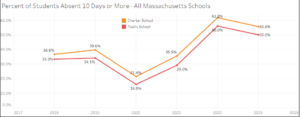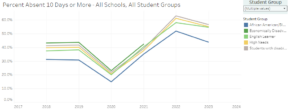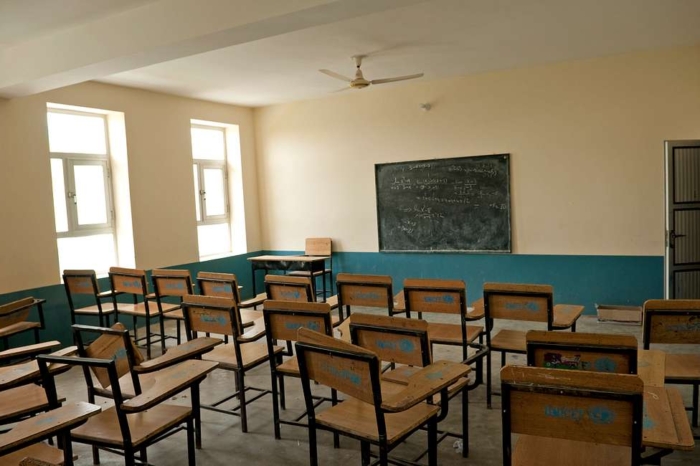Making Sense of Post-COVID Student Attendance Data in Massachusetts
The COVID-19 pandemic has had a profound impact on how often students attend school. Following the shutdowns in 2020, there was a steep increase over multiple years in the number of Massachusetts students who were consistently absent. But Pioneer Institute’s Mass Report Cards data also reveals that absence rates in school districts across the state, as well as across several demographic groups, are heading in the right direction.
Absences Rising
The percentage of Massachusetts public school students who were absent 10 days or more was relatively low in 2020. In district schools, 16 percent of students were absent 10 days or more, while 21.4 percent of charter school students were absent 10 days or more. These numbers, however, rose quickly. In 2021, 29 percent of district school students were absent 10 days or more, while 35.5 percent of charter school students were absent 10 days or more. Percentages then jumped even more in 2022, to 56 percent and nearly 62 percent in district and charter schools, respectively.

This trend is also evident across demographic groups. Every group experienced low numbers in 2020, and then dramatic increases in 2021 and 2022. About 23 percent of economically disadvantaged students were absent 10 days or more in 2020, but that number jumped to over 42 percent in 2021. The percentage of students with disabilities who were absent 10 days or more increased nearly three fold, as the 2020 percentage of 21.8 rose to 63 percent in 2022. The percentage of English learners who were absent 10 days or more increased from 20 percent in 2020 to nearly 60 percent in 2022. Students with high needs and African-American students each saw increases of more than 35 percentage points in their percentage of students absent 10 or more days.

Room for Optimism
These graphs, while illustrating an alarming trend between 2020 and 2022, also indicate a positive trend in the last year. The data for each of the demographics mentioned, as well as data for all school districts and students, indicate that absence rates are now on the decline. The percentage of students absent 10 days or more in both district and charter schools fell by six percentage points or more between 2022 and 2023. Furthermore, every demographic except Native Hawaiian or Pacific Islander students saw decreases in their percentage of students absent 10 days or more in 2023.

Undercount?
It is also important to note counter-intuitive data between 2019 and 2020. One might expect, considering the school lockdowns began in 2020, that absences would have been higher that year than in 2019. But as the graphs illustrate, absence rates decreased. While this may not be consistent with the numbers between 2020 and 2022, or conceptions about what the data should be, there are some possible explanations as to why this is the case. It may be because many schools stopped taking regular attendance during online school during 2020, as well as because of a lack of a unified standard for what qualifies as attendance across school districts.
This undercount may make the increase in absences between 2020 and 2022 seem larger than it actually was. Nonetheless, across the state and various demographics, the graphs still show sizable increases in percentages of students absent 10 or more days from 2019 to 2022. Also, a lack of attendance taking in schools in 2020 does not take into account the climbs in absences between 2021 and 2022. It is clear that regardless of whether there was an undercount in 2020, student absences in Massachusetts increased substantially between 2020 and 2022.
The fact that there may have been an undercount paints the 2023 numbers even more positively. The 2023 data for absences appears to be close to the 2019 numbers. This shows that Massachusetts student attendance is approaching what it was before the lockdowns, which points to some of the effects of the pandemic on K-12 education being mitigated.
Conclusion
Hopefully, these data are a sign of things to come for Massachusetts. The COVID-19 pandemic impacted many aspects of life in the Commonwealth, but the impact that remote learning had on students cannot be overstated. Getting more students attending school consistently is a key factor for educational recovery from the pandemic. These numbers show that we are heading in the right direction, but there is still more work to be done to get them back to pre-pandemic lows.
About the Author
Matt Mulvey is a Roger Perry Transparency Intern at the Pioneer Institute. He is a rising senior at Swarthmore College where he is a political science major and history minor.



